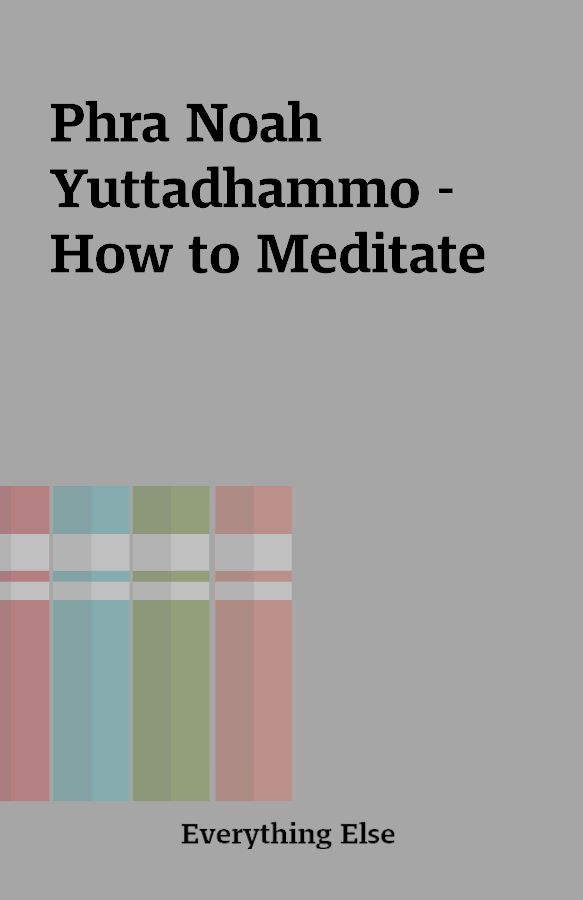Phra Noah Yuttadhammo – How to Meditate
Phra Noah Yuttadhammo_How to Meditate.avi
[1 DVD – 1 AVI]
Description
It was shot by a professional film crew in Chiang Mai, Thailand in High-Definition Video and made into a professional quality DVD. It features the Western Thai Buddhist Monk Phra Noah Yuttadhammo of Sirimangalo.org teaching Vipassana meditation in the Theravada Tradition of Ajaan Tong Sirimangalo of Wat Phradhatu Sri Chom Tong Voravihara, Chiang Mai.Sirimangalo.org is a non-profit organization dedicated to supporting the practice, study and teaching of Buddhist Insight (Vipassana) Meditation, in the tradition of Ajaan Tong Sirimangalo. The organization was founded by Phra Noah Yuttadhammo in order facilitate the spread of Vipassana meditation around the world.Fundamentals of PracticeWhen practicing Vipassana in line with the Four Foundations of Mindfulness, there are some important basics of practice, as follows:1. One must practice in regards to the present reality.Whether it be the noting of “rising, falling”, or “right goes thus, left goes thus”, one must note in the present reality. The mind noting “rising” and the belly that rises must go together; neither one should come before or after the other. At the moment of noting “right”, one must lift the right foot up right away. At the moment of noting “goes”, one must shift the foot, stepping out right away. At the moment of noting “thus”, one must similarly lower the foot to the floor at once.2. One must practice continuously.When one has finished mindful prostration, one must go on to walk, then go on to sit according to the set time; the three should be performed together in a connected sequence. During rest periods, one must go about noting in regards to the minor postures as well; for instance, washing one’s face, showering, eating food, urinating or defecating, extending one’s arm, flexing one’s arm, etc. Even when lying, one must note “lying, lying”, then note “rising, falling”, until one falls asleep. Mindful prostration is to establish mindfulness to stay with the hand. Walking meditation is to establish mindfulness to stay with the foot. Sitting meditation is to establish mindfulness to stay at the front of the belly, and follow the various points.3. The practice must include three qualitative factors:atapi – energetically putting one’s heart into really and truly being mindful;satima — having mindfulness, remembering and knowing at the moment when bodily (rupa) and mental (nama) phenomena arise;sampajano — maintaining mindfulness, following the noting, maintaining the knowing of rupa and nama at every moment, just like a person rocking a crib whose line of sight must stay with the line of the rocking crib at every moment.4. One must adjust the faculties / powers (indriya / bala), keeping them balanced.Faith (saddha) must be balanced with wisdom (pañña). Effort (viriya) must be balanced with concentration (samadhi). Mindfulness (sati) is the faculty that guards and controls – the more mindfulness one has, the better. But if faith is high but wisdom low, greed (lobha) will come to take over. If wisdom is high but faith low, doubt (vicikiccha) will come to take over. If effort is high but concentration low, distraction (uddhacca) will come to take over. If concentration is high but effort low, drowsiness (thina-middha) will come to take over. Whether the practice will bring fruit slowly or quickly lies in this adjusting of the faculties / powers.The Present Reality (paccuppanadhamma)Why is it necessary to put such great emphasis on the present reality? This is because, in meditation practice, if one doesn’t note according to the present reality, one’s practice will not bring fruit, since one’s moment to moment concentration (khanika samadhi) won’t be able to collect together. If, however, one notes according to the present reality, the moments of concentration will then be able to collect together and the faculties and powers will have a greater, more mature strength. Noting according to the present reality is thus an important factor, as it causes moments of concentration to collect together as one.Once one practices on to reach the fourteenth stage of knowledge (magga-ñana), the faculties and powers, which have become strong, mature through the collected moments of concentration, will perform the task of abandoning the defilements automatically, such that there is, from then on, no need to go about troubling oneself in any way; it is enough that one has practiced correctly according to the fundamentals that have been expounded herein.Noting is the heart of the practice of Vipassana. It is the function of mindfulness to continue to note, continue to stay aware at all times; this is what allows one to let go of all existential phenomena. Repeated and continuous noting will strengthen and mature one’s concentration and, just like stopping up a leaking hole, will prevent evil from flowing in to reach the heart, as it will bring one to see only the arising and ceasing of rupa and nama at all times. At the time when one is noting and aware, this is when life has real worth.
You must be logged in to post a review.






Reviews
There are no reviews yet.